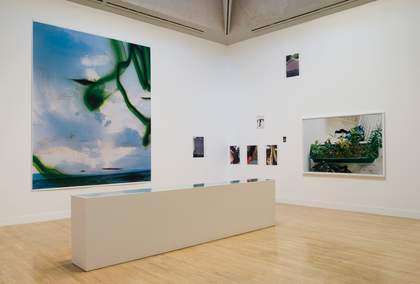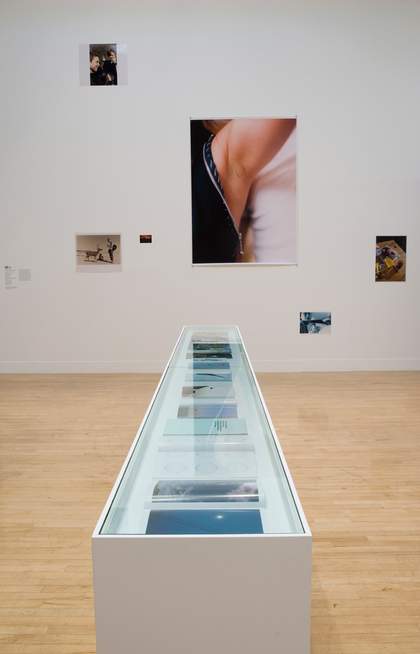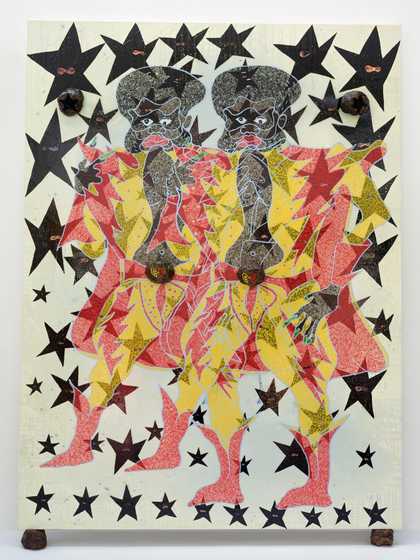
View of Turner Prize: A Retrospective exhibition showing an installation of photographs by Wolfgang Tillmans
Fondation Cartier pour l'art contemporain, Paris
© Courtesy Lisson Gallery and the artist Photo: Tate Photography
Throughout these years visitor attendance continued to climb, peaking at a record high of 140,000 in 1999. The exhibitions regularly attracted derisive tabloid headlines, which sometimes positioned the artists unfavourably and led to concern that the prize was becoming a victim of its own success.
In 1998 Chris Ofili was the first painter to win since Howard Hodgkin, over ten years before. In the following year, media coverage focused on Tracey Emin whose highly confessional work and celebrity status gave her the unofficial crown of ‘the people’s choice’. However, the prize was awarded to internationally acclaimed artist Steve McQueen who won for his film and video works.
2000 saw a refreshingly ‘sensation-free’ shortlist, which prompted discussion about the demise of the YBAs (Young British Artists). The issue of nationalism in relation to a ‘British’ art award was also debated, as only one of the four shortlisted artists was born in Britain. German born Wolfgang Tillmans claimed the prize for his photographic installations.
Artists and works on display:
Chris Ofili
No Woman, No Cry 1998
Acrylic, oil, polyester resin, paper collage, map pins and elephant dung on canvas
Tate. Purchased 1999
Double Captain Shit and the Legend of the Black Stars 1997
Acrylic, oil, polyester resin, paper collage, map pins and elephant dung on canvas
Tate. Purchased with assistance from Evelyn, Lady Downshire’s Trust Fund 1997
No Woman, No Cry is a tribute to teenager Stephen Lawrence, who was killed in South London as the result of a racially motivated attack in 1993. Each of the tears shed by the woman in this painting contains a collaged image of Stephen Lawrence’s face and the words ‘RIP Stephen Lawrence’ are just discernible beneath the paint’s surface.
Double Captain Shit and the Legend of the Black Stars tackles issues of sexual and racial stereotyping in a witty yet insightful manner. In 1996 Ofili began a series of paintings featuring a character inspired in part by Marvel comic’s 1970s fictional superhero Luke Cage. In his spandex outfit and dungball belt, Captain Shit is an ironic symbol of black superstardom.
Steve McQueen
Deadpan 1997
16 mm black and white film, without sound transferred to DVD
4 min 30 sec
Courtesy Thomas Dane Gallery, London and Marian Goodman Gallery, New York
In Deadpan, McQueen uses a famous stunt from the 1928 silent film Steamboat Bill Jr featuring Buster Keaton. In one scene he stands in a house as it collapses around him. Here, the original slapstick moment becomes deadpan and tense as McQueen himself becomes the solemn protagonist, barely flinching as the timber structure falls around him.
The image fills the entire gallery wall so that the viewer feels directly implicated in the drama. McQueen continually plays with the language of film to create absorbing and technically innovative works that have a powerful, almost physical presence.

Installation by Wolfgang Tillmans in the Turner Prize: A Retrospective exhibition
Photo: Tate Photography © Tate 2007
Wolfgang Tillmans
Turner Prize Installation, 1986–2000 2000
Rhythm is Rhythm 1999
moonrise, Puerto Rico 1995
Paul, New York 1994
Circle Line 2000
On the Verge of Visibility 1997
I don’t want to get over you 2000
U-Bahn Sitz 1995
Victoria Line 2000
Central Line 2000
Piccadilly Line 2000
Socks on radiator 1998
fresh tarmac 1996
Nightswimmer 1998
windowbox 2000
Courtesy the artist and Maureen Paley, London
Tillmans’s subject matter ranges from intimate portraits to impromptu still lifes and landscapes, shifting focus ‘from the micro to the macro … to the personal and public and back’. While many of his images appear spontaneous and improvised, some are in fact carefully staged while others are made in the spur of the moment. Since 1998 he has developed new abstract pictures using light effects in the darkroom. His installations are carefully constructed with the juxtaposition of every photograph rigorously considered, mixing inkjet prints with photographs and offest prints taped directly to the wall.

